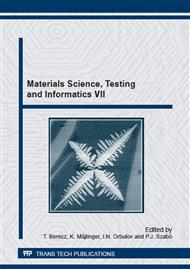p.413
p.419
p.425
p.435
p.441
p.447
p.453
p.459
p.465
Determination of Dislocation Density in Cubic Systems
Abstract:
From the lattice orientation of a sample, elements of the Nye-tensor can be determined. With the help of Nye’s tensor, dislocation density can be calculated for the certain sample. Since the measures were carried out with scanning electronmicroscope (SEM), just superficial orientations can be measured. Hence the Nye-tensor is an incomplete matrix, with five elements. Because of the absence of the other four elements just a quasi-dislocation density can be obtained. The algorithm of the calculation was programmed on the language C#.
Info:
Periodical:
Pages:
447-451
Citation:
Online since:
February 2015
Authors:
Keywords:
Price:
Сopyright:
© 2015 Trans Tech Publications Ltd. All Rights Reserved
Share:
Citation:


